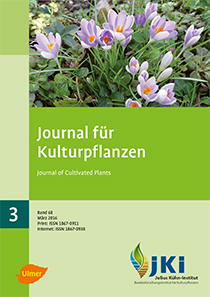Contamination pathways and detection of human pathogenic <em>Escherichia coli</em> from plant foods
Keywords:
Escherichia coli, human pathogenic, contamination, plants, sprouts, food, plant flora, EHEC, diagnostic, virulence factor, quantitative real-time PCR, accumulation, different mediaAbstract
With the massive EHEC O104:H4 outbreak in summer 2011, vegetables became interesting to the German public because of their possible role as a source of infections with enterohemorrhagic Escherichia coli (EHEC). The search for the source of infection with EHEC O104:H4, which was responsible for more than 4000 diseases, more than 800 cases of renal failure and 53 deaths, proved difficult, although the relevant diagnostic properties based on the isolates from the patients were early known. Epidemiological studies pointed to plant foods as possible source and after the wrongly suspected cucumbers, fenugreek sprouts from a particular manufacturer were identified as the primary source of infection. The diagnosis of pathogenic E. coli from plant foods is more difficult than from animal sources, for the latter official control procedures and a variety of methods are published since many years. Investigation methods that were designed for dairy and meat products are not well suitable for testing raw foods of plant origin. The reasons are partly due to the quantity and composition of the accompanying flora of microorganisms, which is completely different in plants than in animal products. Depending on the raw food category (fruits, vegetables, mixed salad and sprouts) the natural microbial contamination of certain plants differs largely in its amount, characteristics and composition. E. coli is often present as contaminant in plant foods, but often in such small quantities that specific enrichment methods are needed to identify potential pathogenic E. coli types such as EHEC. The other hurdle lies in the isolation of suspected E. coli from an abundance of natural accompanying organisms. Quantitative PCR (qPCR, real-time PCR) methods have been proven to detect even low levels of E. coli in plant tissue and simultaneously to identify possible human pathogenic bacteria. Finally, for the isolation of pathogenic E. coli from plants specific methods adapted to this particular food matrix must be chosen. These are also presented here.
DOI: 10.5073/JfK.2016.03.01, https://doi.org/10.5073/JfK.2016.03.01
Downloads
Published
Issue
Section
License
The content of the journal is licensed under the Creative Commons Attribution 4.0 License. Any user is free to share and adapt (remix, transform, build upon) the content as long as the original publication is attributed (authors, title, year, journal, issue, pages).
The copyright of the published work remains with the authors. The authors grant the Journal of Cultivated Plants, the Julius Kühn-Institut and the OpenAgrar repository the non-exclusive right to distribute and exploit the work.







